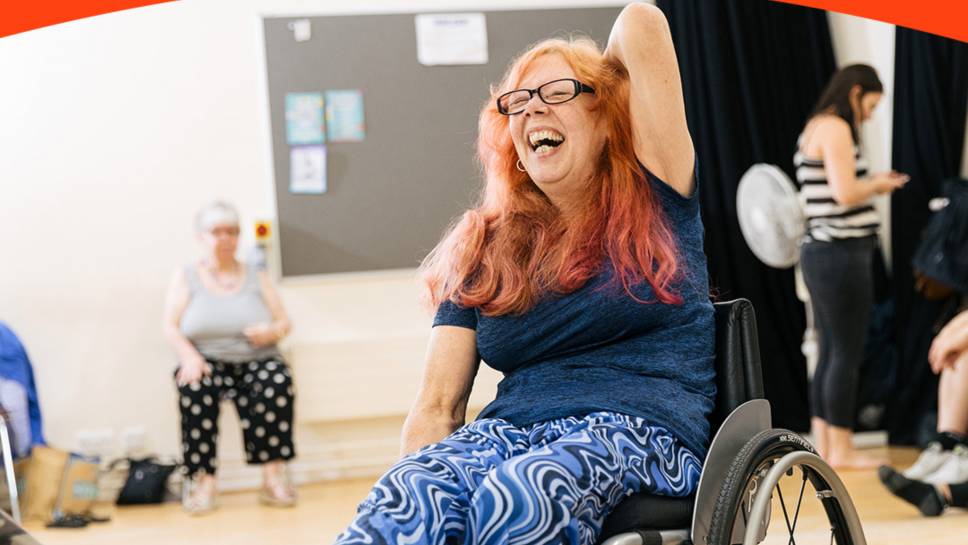
When I was diagnosed, my medical team said that I would need to use a powerchair and that my condition would deteriorate, which it did – pretty fast. I was told that even with years of intense physiotherapy, it was highly unlikely that I could ever rebuild wasted muscle and improve my mobility.
I needed a power chair with lateral supports to help me sit upright and my upper body mobility was very poor. Daily tasks, such as putting on shoes, getting dressed, and doing light housework, would leave me breathless. I was prescribed non-invasive ventilation to regulate my breathing overnight and I needed it during the day after doing these daily tasks. I would often fall and couldn’t stand for long enough to pull up clothing.
I was very overweight, which meant my body had to work even harder to manage everyday life. I weighed 103kg. My diet was full of junk food – high fat, high sugar, and lacked essential nutrients.
“Something strange happened – a global pandemic”
The waiting list to see a physiotherapist was growing and I was working from home, so I decided to take it upon myself to start moving gently. I would sit in my powerchair and hold on to my hoist, then using the remote control I would press the button and take my arm up to where it felt comfortable. Just to be able to feel the stretch in my arm.
I saw people on Facebook complaining about not being able to go to the gym anymore and I thought “welcome to my world”. But then I saw people sharing exercise classes online and I joined very gentle ones which were aimed at older people.
I started doing my own gentle exercises, making up routines and purchasing a few gadgets online. I went to an MDUK Muscles Matter seminar, where a physiotherapist showed us simple moves we could do safely. I started off very slowly, afraid of failing, afraid of falling, pulling a muscle in the process, or even risking making myself worse somehow.
I also started following a mindful eating programme. I exercised daily and ate a high protein plant-based diet, and the weight began to fall off, and my mobility began to improve.
Exercise has changed my life
Three years later and my medical team are really pleased to see the progress I have made in improving my muscle strength and mobility, and that I no longer need to use a BiPap machine. I now weigh 54.4kg and have more energy to do the things I love doing.
I’ve swapped my powerchair for a self-propelling sports-style chair and no longer need lateral supports. I’ve regained full bladder control and under the supervision of my respiratory nurse, I’ve weaned myself off the ventilation support.
I’m a regular at the local gym and I go to an inclusive dance class in town twice a week. I recently joked with my physiotherapist saying “Look! Are these biceps or is it my imagination?” she said, “Yes, you can see the muscle definition!”
Becoming a fitness instructor
Last month, I passed my final exam to become a fitness instructor, nutrition advisor, and personal trainer. I was enrolled on these courses after having an interview at the local Job Centre, where we discussed my experience and interests. I couldn't believe that they paid for me to do my training.
I used to be a dancer and I’ve taught dance classes in the past. But after my diagnosis, I thought I could only ever dream of being able to dance again. Now, I choreograph wheelchair dances and fitness routines and am showing the ways movement can be incorporated into adapted, seated exercises by moving your upper body or using various props for creativity. It’s beautiful.
I’m also starting classes for older people in residential care and community groups and running online exercise sessions, making my new hobby a career while returning to work part-time.
What I wish I’d known when I was diagnosed
I wish that I’d been encouraged to move more, sooner after my diagnosis. I wish someone would have said there is hope. There is hope that you might one day have core muscles that will allow you to sit upright, be able to stand unaided, and regain full bladder control. I wish they would have encouraged me to try. And if I’d tried and it hadn’t worked, then that would be fair enough. But I went on for so long thinking it would be impossible.
My physio team have been so supportive, which I’m enormously grateful for. Every week, we go to our local swimming pool where they get me to do exercises to improve my coordination, strengthen my muscles and improve my confidence in the water.
I want to motivate other people to start gentle exercise, eat a good balanced diet, manage their weight, and take care of their wellbeing.
I’m not recommending people listen to my story and immediately join a boxercise class or run a mile. Set little goals, take little steps, which is what I’ve done to build my muscles.
You should talk to your doctor or physiotherapist about exercise before you start, especially if you are still undergoing diagnosis or having heart investigations.
It’s important to use caution when selecting the type of strengthening exercise for some muscle-wasting conditions. Check out our information and advice about exercise or catch up on our Muscles Matter webinar about standing physio with Neuromuscular physiotherapist Marina Di Marco.
